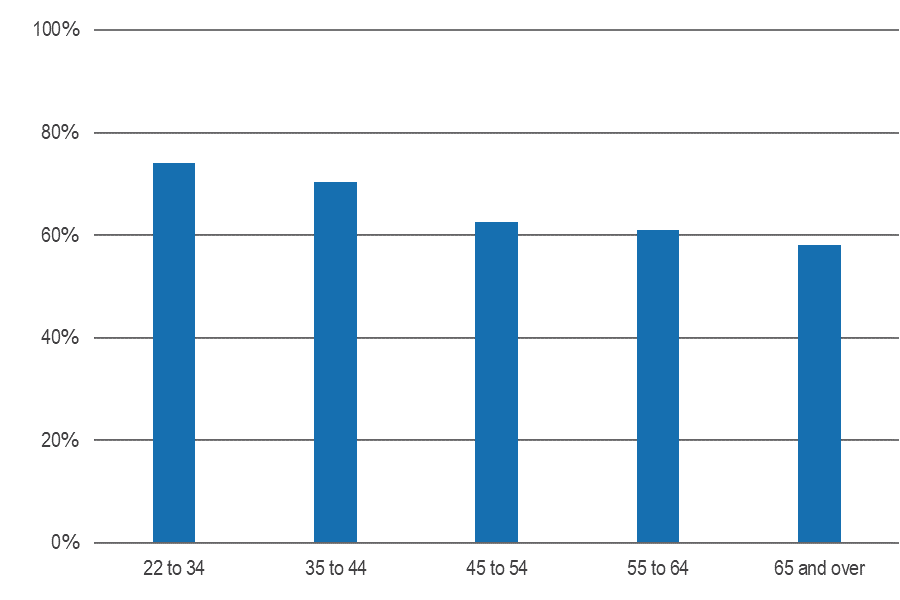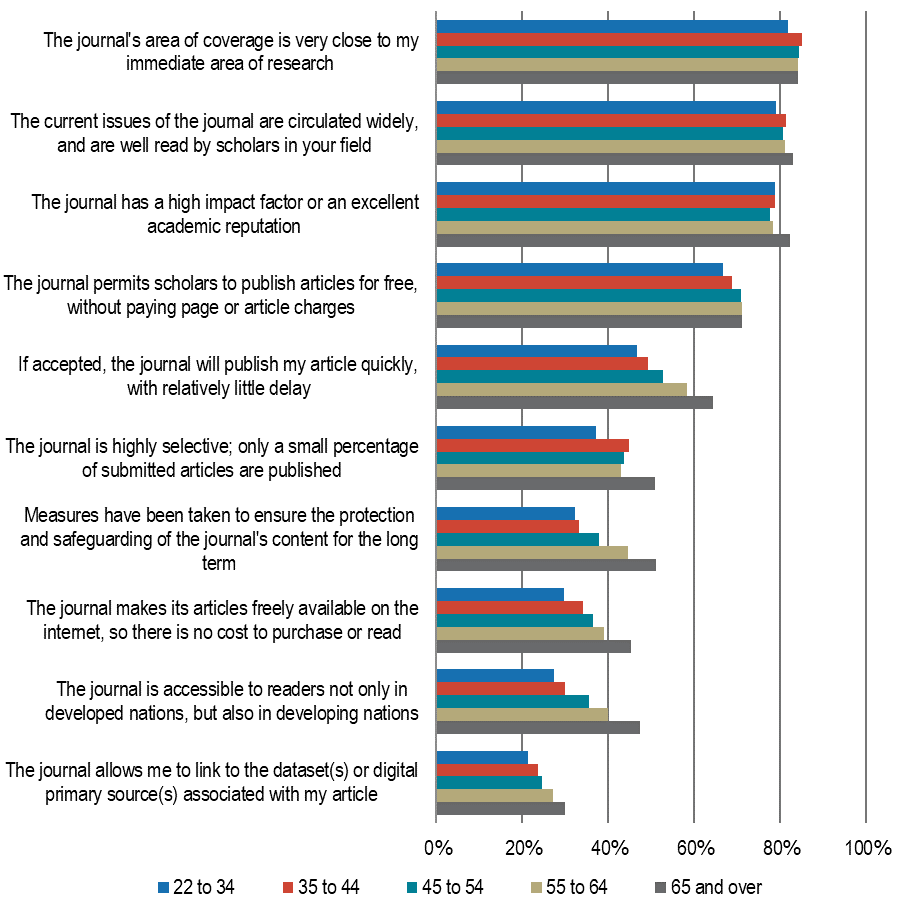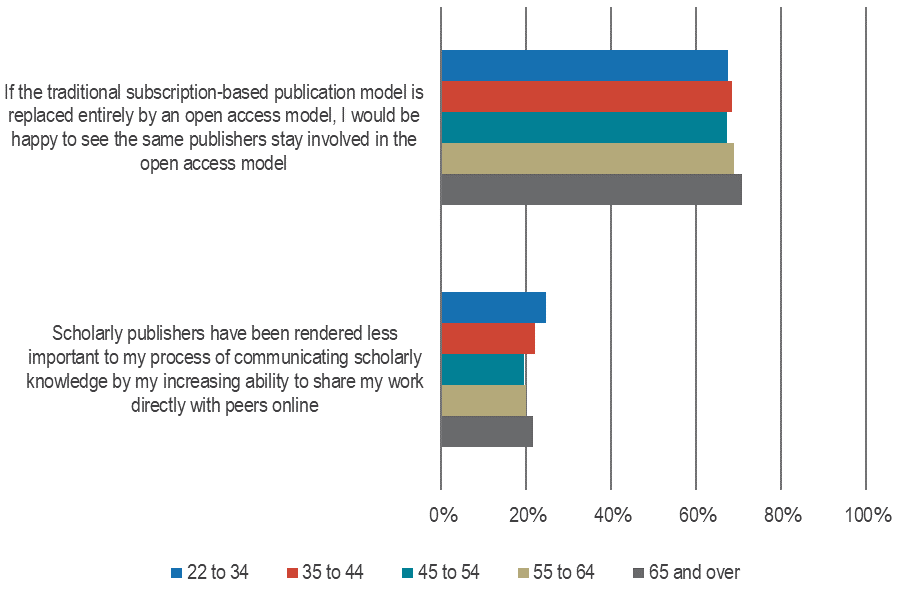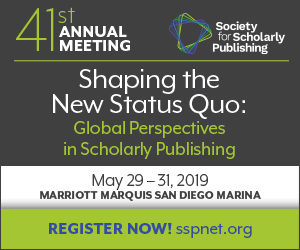On Friday, Ithaka S+R released the latest cycle of our long-standing US Faculty Survey. This survey has tracked the changing research, teaching, and publishing practices of higher education faculty members on a triennial basis since 2000. Here, we highlight some of the key findings around open access that we expect will be of interest to the scholarly communication community. Notably, we find a widening disconnect between faculty attitudes, on the one hand, and reported practices, on the other, related to open access publishing.
Project Background
In this seventh project cycle, we surveyed a random sample of faculty at four-year institutions within the United States. Nearly 11,000 faculty members — from a wide variety of fields — responded, for a response rate of 7.2 percent.
In the questionnaire, we continued to track key topics, including information discovery and access, data management, research dissemination, perceptions of student research skills, and the value of the library. We also added new questions on emerging areas of interest, including open educational resources, learning analytics, and evolving scholarly communication models.
The work of this project was sponsored by Clarivate, Digital Science, Elsevier, Ex Libris, JSTOR, and 15 scholarly societies that allowed us to send messaging to faculty in specific fields under their signatory. In addition, a group of 13 colleges and universities ran a localized version of the survey in parallel with our nation-wide sampling.
Christine Wolff-Eisenberg and Melissa Blankstein are the authors of the survey report, which is publicly available.
Strong Sentiment for Open
Faculty members are increasingly interested in open access publication models. Approximately 64% of the 2018 respondents indicated they would be happy to see the traditional subscription-based publication model replaced entirely by an open access system compared to 57% in 2015. Younger faculty are particularly interested in this pivot; roughly three quarters of faculty ages 22 to 34 agreed with this sentiment compared to less than six in ten faculty ages 65 and older
Percent of respondents by age cohort that strongly agreed with this statement: “I would be happy to see the traditional subscription-based publication model replaced entirely by an open access publication system in which all scholarly research outputs would be freely available to the public.”

Majorities of faculty members in every age group, but especially early career researchers, expressed support for a switch to open access.
Incentives Rule
Notwithstanding this sentiment, traditional scholarly incentives continue to motivate faculty behavior. And, younger faculty members in particular are more likely to face the direct effects of these incentives in processes for job-seeking, tenure, and promotion. As a result, early career researchers are more likely to report behavioral patterns that are inconsistent with their expressed enthusiasm for open access publishing that we discussed above. Indeed, early career researchers often report that they are very closely aligning their research outputs to match the criteria they perceive for success. We observe this across an array of survey findings, but we especially see this pattern of self-reported behavior in one key area.
Faculty continue to value the same characteristics of journals as they have historically. They most highly value a journal’s area of coverage aligning closely to their immediate area of research, the current issues of the journal being circulated widely and being well read by scholars in their field, and the journal having a high impact factor or excellent academic reputation.
Faculty are relatively much less concerned about the extent to which a journal makes its articles freely available. Greater shares of respondents, in comparison, expressed concerns about the costs that they themselves might incur during the publication process through article processing charges. Older faculty, however, find notably more value than younger faculty in a journal making its articles freely available on the internet with no cost to the reader.
“When it comes to influencing your decisions about journals in which to publish an article of yours, how important to you is each of the following characteristics of an academic journal?” Percent of respondents
by age cohort that indicated that each of these characteristics is highly important.

The overall patterns in reported decision-making about free to read vs. free to publish have not meaningfully changed since 2015. With a notable increase in preference towards open, however, as we reported above, we see that the gap between attitude and practice is widening. Especially among early career researchers, real-world incentives remain misaligned — and indeed appear to be moving further out of alignment — with the drive towards open access.
Open Access Royalty
As one of us has observed in The Kitchen, the read and publish/publish and read (R&P/P&R) deals are pushing towards instantiating the current crop of major publishers as the open access royalty. It is therefore noteworthy that very few respondents agree that publishers have been rendered less important to their process of communicating scholarship because of increased opportunities to share their work directly with others online. Moreover, the vast majority of respondents do not take issue with the publishers currently involved in the subscription based model. Approximately seven in ten would be happy to see the same publishers involved in an open access publication system if the traditional subscription-based model was replaced entirely
Percent of respondents
by age cohort that strongly agreed with each of the following statements.

There is little evidence in our findings to support a groundswell of enthusiasm for replacing publishers, or, for that matter, the editorial and other contributions of scholarly publishing.
Read the Report
This offers just a taste of the full meal of findings available. Please visit the Ithaka S+R website to read or download the full report of findings. You are also welcome to join us for a webinar about the broader array of key findings this Wednesday. We look forward to your comments and questions.
Looking ahead, our team is gearing up for the next cycle our Library Survey of deans and directors, which we will be conducting this fall. We would love to hear what you would like to learn next, on scholarly communications and beyond, from this important community.
Thanks to Kimberly Lutz for reading a draft of this post.
Discussion
20 Thoughts on "Open Access Publishing: New Evidence on Faculty Attitudes and Behaviors"
I wonder how the finding “(T)he vast majority of respondents do not take issue with the publishers currently involved in the subscription based model. Approximately seven in ten would be happy to see the same publishers involved in an open access publication system if the traditional subscription-based model was replaced entirely.” might be different were (1) the faculty fully understood the financial ramifications of the APC model and (2) they also had more to do with paying the bills to these publishers, which go up 5% or more each year.
I’m curious what APC ramifications you’d have them understand?
I would want them to understand that APCs aren’t cheap, especially with the major publishers, and that there is little evidence that an APC-funded model of scholarly communication is less expensive than the traditional model, especially one where there is no shift away from the Big Five. It is also unclear who is going to pay for these APCs, especially in the humanities and humanistic social sciences, and at less wealthy schools overall. It’s all well and good to be in favor of open access, but there are financial issues that need to be thought through.
Hmmm. I think they do know those things. I’ve never heard any faculty say they are surprised how inexpensive an APC is!
“I’ve never heard any faculty say they are surprised how inexpensive an APC is!” Happens to me all the time, as editor of a free, no APC, academic-run, journal with a budget of $0. Authors wonder why STEM journals in particular are charging high APCs for a similar service. Fortunately, authors are often happy to recompense our voluntary efforts with some refereeing.
I imagine other such editors are in the same position. Listing, for social sciences, of some other journals is here https://simonbatterbury.wordpress.com/2015/10/25/list-of-decent-open-access-journals/
Surprised there is no APC is rather different than surprised at how low an APC is to me. Perhaps, my training as a philosopher coming out.
To me, those 2 items wouldn’t have an effect on not taking issue with having the same publishers involved, but with their like of an Open Access free immediately model. If everything is open access immediately, that is a factor of the system not the publisher, so I don’t see any disconnect with them saying that they don’t have a problem with the same publishers doing open access.
I agree that thinking that everything should be open immediately might be different if they looked at how the costs would shift demographically from subscribers to researchers and their institutions. For example, if I’m in an industrial company that does research, I might well subscribe to journals under the current system, but wouldn’t have to in an all open system, and the company may not do much publication, so their costs would go down. Different academic institutions’ costs may go up or down depending on their publication volume vs need for journals. Developing countries will have problems either way, unless there is a way for their purchases of subscriptions or of APCs to be subsidized.
The Research4Life initiative provides free or extremely low-cost access to some 22,500 scholarly journals for researchers in 9000 registered institutions across the Global South. It also includes all of the OA journals listed in DOAJ, so that they are discoverable alongside subscription journals.
There are concerns that a wholesale shift to Gold OA publishing may exclude researchers from emerging markets, unless they can secure funding to pay APCs or, indeed, unless they are made aware of publishers’ APC waiver policies. This information is often very difficult to find, and is usually only offered once a paper has been accepted for publication. At Research4Life we are exploring ways this information can be more transparent.
Once upon a time, many of the societies had journals which had page charges which then allowed the journals to be reasonably priced to members and others. Open Access is a variance. The issue here is the “rank” or value of the journal for the purpose of pub/perish which seems to hold
I wonder, with the low response rate for this survey, how meaningful is the data reported
Taking into account the number of responses we’ve attained in this study as well as the size of the broader population, we can be highly confident that the responses represent the population with a very small margin of error. And, to correct for relatively higher/lower response rates from faculty within specific fields, we also re-weight the aggregate responses by field to match the sample parameters to the population.
Hi Christine, Roger
a) Since this survey is a continuance, what have we learned or can intuit that is new or shows a shift among authors.
b) What impact has this survey and related had on publishers, particularly the “big 5” or on the number of publishers entering the field of OA and the ramifications thereof.
c) Of more importance, what has been the change in attitude of those who use journals for promotion/tenure and similar decisions wrt open access publishers in general and the “big 5” entering the OA marketplace. It would seem that any changes here would ripple thru both the authors and the publishers since these decisions drive choices of authors and evaluators.
Did you test for non-response bias.
While we follow up with invitees multiple times during the time when the survey is being fielded to reduce non-response bias, we do not test for non-response bias after the survey has been conducted. We do, however, weight responses to reflect population parameters by field, compare demographics of respondents across survey cycles, and stratify responses to examine differences by subgroups when we know there are differences between the sample and population demographics.
I wonder. What will happen when OA costs become a major line item on the funders balance sheet. If a funder like Gates or Welcome Trust says what are we doing? Why are we funding some professors career on the one hand and supporting a publisher on the other! The university administration will say why are paying for our faculty members to publish? We didn’t in the past! Professors will say: What I have to take money out of my pocket or grant to get a paper published! Why?
In the end we will have what we have and it will take another 30 years to sort things out especially when the university assigns a committee to look into the matter.
Of course a lot of us are fighting high APCs by commercial publishers. Volunteering labour, working efficiently and cheaply including as editors, using non-commercial software like OJS, flipping commercial journals – see freejournals.org for example. Also supporting society and smaller publishers, educating colleagues, and publishing ethically. All of these could be the future – but only if ‘gatekeepers’ – senior scholars and librarians – are on board and showing the importance of these issues to the next generations [particularly, ‘publishing ethically’]. Big strides have been made in certain disciplines – but there are also holdouts, and consolidations and buyouts by the ‘big 5’ with their financial power and often big profits, have been disappointing.
Thanks Roger and team for another interesting and useful report. The findings are similar to those of our PIF study, but it’s interesting to see the progression. Although I don’t care for the idea of crowning open access royalty, which seems like a very loaded phrase, your findings suggest that we at UC are on the right track – faculty do want OA, but by and large they want it in the journals they already value. This is exactly what we’re trying to accomplish. And responding to Mike Roy’s comments, we’re also hoping to introduce some price sensitivity into the equation to further ground those choices, as well as facilitate OA for HSS authors.
In a country like India if u have an article in a open access journal and it’s takes APC then it’s is considered as a paid journal and you don’t have any reputation, because people believe that you have given money for publication and your work is not up to the mark. It’s a big concern for researchers in India. In my opinion if journal were taking APC then the reviewer also get benefit from that in the form of revenue. It will good for researchers, reviewers and the response from from the reviewer will come at the possible time. IEEE Access is one good journal having APC.
It’s notable that a much higher percentage (65% or more) consider it highly important to have no charge to authors for publishing (subscription model), compared with the 30-40% concerned with no cost to read or purchase (open-access model).
You may be interested to know that well in advance of these developments and Plan S, IGI Global has been providing a transformative open access offset model, IGI Global’s OA Waiver (Offset Model) Initiative, that is subsidizing the open access article processing charges (APCs) for researchers when their work is submitted and accepted into an IGI Global journal when their institution’s library invests in one of IGI Global’s research databases. View full details: https://www.igi-global.com/publish/contributor-resources/open-access/.

